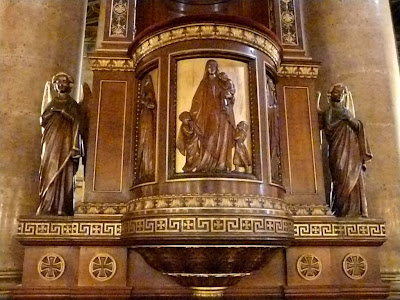Full Sets of Images by the Jeunes-France/ Bouzingo
Selections with commentary are being updated below, but do not yet include all of the visual artists working within the group; link below for more images by all artists.
Louis Boulanger
Jehan du Seigneur
Achille Devéria
Eugéne Devéria
Célestin Nanteuil
Napoleon Thom
SELECTED OBJECTS BY THE JEUNES-FRANCE:
Louis Boulanger
Louis Boulanger, The Torture of Mazeppa, 1827.
Louis Boulanger,The Witches' Sabbath (Souvenir of Victor Hugo), 1828.
Louis Boulanger, Paolo and Francesca, c. 1830-35?
* * *
Jehan Desiegneur
Selections with commentary are being updated below, but do not yet include all of the visual artists working within the group; link below for more images by all artists.
Louis Boulanger
Jehan du Seigneur
Achille Devéria
Eugéne Devéria
Célestin Nanteuil
Napoleon Thom
SELECTED OBJECTS BY THE JEUNES-FRANCE:
Louis Boulanger
Louis Boulanger, The Torture of Mazeppa, 1827.
At 21 years of age, Boulanger won a medal in the Romanticist wing of the 1827 Salon for this piece, where it was exhibited alongside Devéria's Birth of Henry IV and Delacroix's Death of Sardanapalus. In treating the story of Mazeppa, tied to a horse and dragged for miles over open ground in vengeance for his indiscretions with his Lord's wife, Boulanger was participating in a vibrant Romanticist tradition: the British Romanticist Byron had first written a poem on the subject in 1819; Hugo would write another poem the year following this painting's exhibition, as would the Russian Romantic Pushkin the same year, while Franco-Polish Romanticist Franz Liszt would write a symphonic poem on the subject in 1840.
Louis Boulanger,The Witches' Sabbath (Souvenir of Victor Hugo), 1828.
This painting illustrates a poem from Hugo's landmark collection of Romanticist Verse, Odes and Ballads, published two years earlier. Boulanger produced a lithographic version of the piece as well.
Louis Boulanger, Paolo and Francesca, c. 1830-35?
The adulterous pair is murdered by the latter's husband, to be immortalized in Dante's Inferno. A typical theme for the Jeunes France, combining lust with bloodlust. The sketch is reminiscent in some ways of the erotica of Boulanger's teacher and fellow Bouzingo, Achille Devéria.
Louis Boulanger & Célestine Nanteuil, The Lycanthrope, c. 1830-31
Fellow Bouzingo Célestin Nanteuil produced this lithograph based upon Boulanger's portrait of the arch-Frenetic Romanticist, Petrus Borel, known as 'The Lycanthrope'. Several years later, Borel would be so destitute that he would have to give away his constant companion, the dog pictured here; he could no longer feed both himself and the animal.
Louis Boulanger, Oriental
No date on this yet. A non-specific 'Eastern' motif such as Romanticist painters so enjoyed as another route of protest against the prerogatives of Western Classicism.

Louis Boulanger, study for Liberty, 1830.

Louis Boulanger, Portrait of Achille Devéria, 1837.
A portrait of Boulanger's former teacher, friend, and former Bouzingo Achille Devéria. This painting was executed while both were working with the Bohême Doyenné group.
Louis Boulanger, Lenore.
Lithograph based on the German proto-Gothic poem by Gottfried August Bürger.
Louis Boulanger, Ghosts.

Louis Boulanger, study for Liberty, 1830.
Colour study, presumably for a history painting celebrating the July Revolution of 1830, which some of the Romanticists had fought in and all fervently supported. Many, including Borel, O'Neddy, Hugo, Béranger, and others, became bitterly disillusioned when the revolt ended in the establishment of another, slightly more liberal Monarchy. Delacroix's (now famous) painting of the same subject was bought by the new government only in order to be kept out of sight of the public lest it serve as inspiration for another revolt.

Louis Boulanger, Portrait of Achille Devéria, 1837.
A portrait of Boulanger's former teacher, friend, and former Bouzingo Achille Devéria. This painting was executed while both were working with the Bohême Doyenné group.
Louis Boulanger, Lenore.
Lithograph based on the German proto-Gothic poem by Gottfried August Bürger.
Louis Boulanger, Ghosts.
* * *
Jehan Desiegneur
Jehan du Seigneur, Orlando Furioso, 1831.
Widely hailed as the first truly Romanticist sculpture when it was exhibited in the Salon of 1831, this piece established the 23-year old de Seigneur as one of the most influential visual artists in the Romanticist community. The subject is drawn from the most famous of the Medieval 'Romances' from which "Romanticism" itself derives its name; before even considering the treatment, in choosing this subject rather than either Classical or Biblical imagery Duseigneur was already throwing down a gauntlet to the Academy and, by extension, the artistic ideology of the French State.
Jehan Du Siegneur, Medallion of Gérard de Nerval, 1831.
This relief sculpture adorns the grave of fellow Bouzingo Nerval. In the communal homes of the Jeunes France & Bouzingo in the 1830s, the walls were decorated with a plaster 'medallion' of each member. Seigneur could not afford to cast them in bronze, and all were lost or destroyed except the sculpture of Nerval, which Gautier managed to save. A bronze was finally cast from it after Nerval's suicide twenty years later.
Jehan de Seigneur, Copy of an Italian original. Date unknown.
Not much information on this yet; seems likely to have been done during or shortly after his student days.
Jehan du Seigneur, Dagobert, 1836-39.
Marble sculpture of the Merovingian king, reflecting the return to the 'barbarous' Medievals that the Romanticists used as a lever to throw off the Enlightenment forms of thinking represented and perpetuated by Classicism.
Jehan Duseigneur, Alter, Church of Saint-Vincent-de-Paul, Paris, 1844.
Following his encounter with the Catholic Socialism of Bouchez, Du Seigneur turned to an even deeper re-evaluation of Medieval art and its function in relation to society, culminating in a career in church decoration and planning.
Jehan Duseigneur, Angel, Church of Saint-Vincent-de-Paul, Paris, 1844.
Jehan du Seigneur, Basilica of Notre-Dame-de-Bonsecours, c. 1844-46.
DuSeigneur can be seen further simplifying his sculpture, returning to the mannered anatomy and clean expressive line characteristic of medieval Gothic sculpture.
Jehan du Seigneur, Basilica of Notre-Dame-de-Bonsecours, c. 1844-46.














